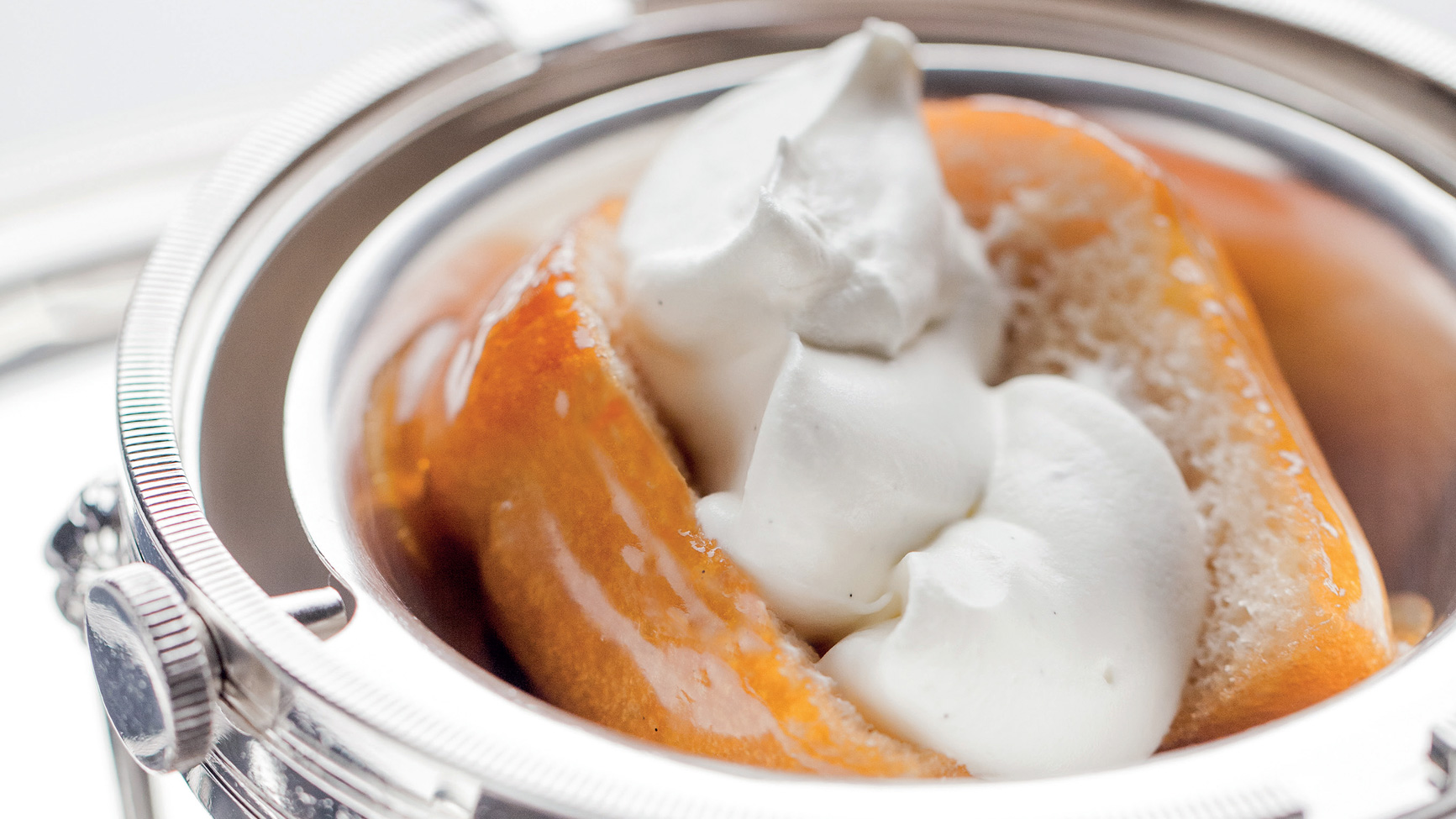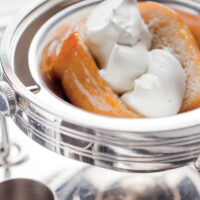
Alain Ducasse’s rum baba
A divine dessert with a royal pedigree, these little yeast cakes are soaked in sweetened rum and topped with a generous dollop of vanilla cream. Alain Ducasse’s recipe is a favourite at The Dorchester in London.
Read our French Chef Highlight on Alain Ducasse
Our friends at France Today hosted an exclusive online event interviewing Chef Alain Ducasse brought to you in collaboration with Federation of Alliances Françaises USA. Members can watch it back any time and they’ve kindly offered a free 30-day trial to our readers which you can claim here.
Cake heaven: The origins of rum baba
Apparently, we can thank Stanislas I, the Duke of Lorraine, for the lovely rum baba, which originally hails from his native Poland. The story goes that he arrived in eastern France and found the local gugelhupf cake too dry, so he instructed his pastry chefs to douse it with alcoholic spirits.
“As a dedicated reader of The Thousand and One Nights, he is said to have named this creation after his favourite hero, Ali Baba,” according to Larousse Gastronomique. “This recipe was a great success at the court of Nancy where it was usually served with a sauce of sweetened Malaga wine.” (However, some food historians believe the ‘baba’ in the name actually derives from the same Slavic word meaning ‘old woman’ or ‘grandmother’.)
What is almost certainly true is that one of Stanislas’s pastry chefs, Nicolas Stohrer, was the man who originally doused the gugelhupf cake with Malaga wine. After moving to Paris, in 1730, he opened his famous pâtisserie on Rue Montorgueil, which is still serving Parisians with the finest cakes and pastries today. The modern-day owners of the shop (“the oldest pâtisserie in Paris”) swear blind it was Nicolas himself who invented rum baba. In reality, it may have been one of his descendants who chose to switch the booze from Malaga wine to rum.
Related recipes:
Alain Ducasse’s Rum Baba
Ingredients
Baba
- 130 g 4½ oz all-purpose flour (T55) 1g (1/6 tsp) salt
- 45 g 1½ oz chilled butter (unsalted) 6g (1 tsp) yeast
- 6 g 1 tsp lavender honey
- 180 g about 3½ whole eggs
Syrup
- 3 litres 6¼ pints water
- 1.2 kg 2lb 10½ oz sugar
- Zest of 3 lemons
- Zest of 3 oranges
- 1½ vanilla pods
Apricot glaze (apricot jam can be used as a substitute, but must be strained after heating)
- 500 g 1lb 1½oz apricot pulp
- 266 ml ½ pint syrup
- 12 g ½ oz pectin NH
- 400 g 14oz caster sugar
- 200 g 7oz glucose syrup
- 25 g ¾ oz lemon juice
Garnish
- 50 g 1¾ oz apricot glaze
- Aged rum – according to your preference
Vanilla cream
- 1 litre 2¼ pints whipping cream 90g (3¼ oz) icing sugar
- ½ vanilla pod seeds only
Instructions
- First prepare the syrup. Combine the water, sugar, lemon zest, orange zest, and vanilla pod in a saucepan and bring to the boil.
- After boiling, cool to 45°C/115°F.
- Next, make the apricot glaze. In a saucepan, combine all the ingredients and bring to the boil.
- Boil the glaze for two minutes, while constantly stirring to prevent the pectin from burning on the bottom of the pan. Set aside to cool.
- Now prepare the babas. In a mixing bowl, combine the flour, salt, butter, honey and yeast, and knead the dough, adding the eggs a little bit at a time.
- When ready, the dough should easily come away from the sides of the bowl and be elastic and smooth. Tip it onto a lightly oiled baking tray and spread it out to the edges.
- Allow the dough to rest in a refrigerator uncovered for 10-15 minutes. Once sufficiently rested, transfer the dough into a piping bag (no nozzle needed).
- Lightly oil some dariole moulds with non-flavoured oil.
- Using the piping bag, pipe the dough into the lightly oiled dariole moulds (30g/1oz in each). Tap the base of each mould on a work surface to expel air bubbles, and with lightly oiled fingers clean the edges of the mould.
- Gently cover the filled moulds with oiled cling film and set them to one side at room temperature until the dough rises almost to the top of the moulds.
- Once sufficiently risen, remove the cling film and leave uncovered for another 10 minutes in order to allow the tops of the babas to form a thin skin.
- Bake the babas in an oven at 180°C (350°F/Gas Mark 4) for seven minutes, then turn the tray and continue to bake for an additional five minutes. (Cooking times may vary depending on the oven, and the colour of the babas is a good indicator to determine if they have finished baking.)
- When the time is up, and the babas are golden in colour, remove them from the oven and remove from the moulds. Place the baked babas onto a rack to cool completely.
- Once sufficiently cooled, soak the babas head-down for a minimum of 30 minutes in the lukewarm
- (50°C/120°F) syrup, allowing them to absorb the liquid and swell.
- Drain the babas on a rack for 20 minutes.
- Once drained, using a pastry brush, coat the babas with the apricot glaze and keep them uncovered at room temperature to dry for 15 minutes. 17 Now prepare the vanilla cream. In a bowl, combine the cream, icing sugar, and vanilla bean seeds, and whisk. 18 The cream will be at the right consistency just before the stage when it would form soft peaks.
To serve
- Place a baba into a dessert dish.
- Cut into two halves with a knife and drizzle rum onto the fluffy centres of each half.
- Top the baba halves with the vanilla cream and enjoy.
Initially published in Taste of France Issue 3, courtesy of Alain Ducasse.
Did you enjoy the recipe? Let us know in the comment section below.
Enjoy Taste of France? Well you’re in luck as Taste of France Issue Five is out of the oven!
Latest posts:
- Sardines and onions summer tart
- Brocciu-stuffed sardines
- Mayors banquet: 2 Tonnes of Salmon & 33,000 Bottles of Wine
- Duck liver flan with port coulis
- “Keep your teeth for the cheese”: France’s tastiest mountain biking trail
Lead photo credit : Alain Ducasse’s Rum Baba | Taste of France Issue 3
Share to: Facebook Twitter LinkedIn Email
More in Michelin Starred Chef Recipe, Recipe from Alain Ducasse, Rum Baba Recipe, Traditional French Dessert, Traditional French Recipe







